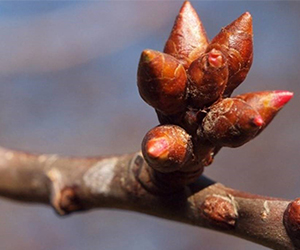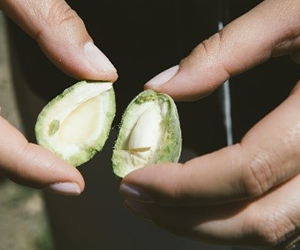Managing orchards is a bit like marriage: It’s a long-term relationship. A mistake today could stay with you for a while, but care and attention to detail can pay benefits year after year.
This analogy demonstrates a vital truth that Sebastian Saa, senior manager for Agricultural Research at the Almond Board of California (ABC), stresses upon growers each year: Attaining optimal yields requires taking the time to get to know your trees – it’s a marathon, not a sprint.
“Everybody wants to experience good yields, and that’s important,” Saa said. “But understanding how to read the tree, how to interact with the tree, is what leads to sustainable yields year after year.”
That means paying attention to what the tree is telling you at each stage of growth, understanding what certain changes or circumstances mean and reacting appropriately. Reading your trees’ signals is particularly important under challenging conditions, as signals can help a grower determine if they need to adjust certain practices. Missing a signal from the trees — or misinterpreting it — could lead to the wrong decision when it comes to fertilization, irrigation or foliar sprays, Saa said.
Misinterpreting your trees’ signals could also mean you’ll miss an opportunity for quality yields, not only this year but next year. This is because while the tree is producing this year’s crop, it’s also getting ready for next year.
In each tree, branches carry fruit-bearing spurs (compacted shoots no longer than 2 inches) that harbor most of the tree’s almonds. These spurs are constantly changing — new ones being born, others bearing fruit, still others dying off, etc. Identifying the different population of spurs in your tree, and what other key parts of the tree are up to, will provide a wealth of important information, Saa said.
Furthermore, understanding and calculating yield comes down to a simple equation: the number of flowers multiplied by the percentage of fruit set multiplied by kernel weight:
No. of flowers × % of fruit set × kernel weight = Yield Potential
But don’t let the simplicity of this formula fool you — the importance of your final count is hardly trivial.
“The formula may be straightforward, but its implications are significant, especially if you can figure out how to manipulate the variables,” Saa said.
Strong Spring Bloom Depends on Previous Year’s Practices
What is it about what is arguably almond trees’ most beautiful feature that makes them so vital to optimal yield?
“More flowers are better, but it’s not just density – flower quality is also important because healthy and fertile flowers are more likely to set fruit,” said Saa. “The flowers you see this year began to develop last year, between August and October. Management during that time is critical.”
One key management practice growers can employ to encourage fruitful flowering involves keeping a healthy canopy of leaves on the tree after hull split and after harvest so that the tree can continue to gather the energy it needs to develop the buds for the following year’s flowers. Conversely, overly stressing the trees before and after harvest can lead to premature defoliation and have a detrimental impact ON flower development.
Because growers irrigate at a deficit to induce conditions that facilitate harvest, the tree is already stressed by harvest, when irrigation is shut down completely. Mild, controlled deficit irrigation during this period is fine, but the problem occurs when the deficit is too long and intense. To prevent early leaf drop, growers should irrigate as soon as possible after almonds are harvested, Saa said.
“We understand growers are very busy during harvest, and that irrigating can be tricky at that time of year, but trying to irrigate as soon as possible should be a priority,” Saa said.
Another key driver of abundant, healthy flowers is the number and type of spurs (compacted shoots no longer that 2 inches) on the tree branches. Flower buds are formed on spurs and therefore spurs are the fundamental bearing structure of almond trees. Trees are constantly cycling through these fruit-producing structures. Each year some spurs are just beginning to grow, some are “resting” after producing fruit the previous year, others are producing fruit, and some are dying after producing fruit in previous seasons. Therefore, observing your trees throughout the season for spur balance can provide important information.

“Manage your trees to keep balanced populations of almond spurs. Make sure that in any given season your tree has recently formed spurs, spurs producing fruit and spurs resting,” Saa said.
Ensuring a good balance of spurs, with fruit for this year and growth for future years, is important to ongoing sustainable yields. Generally, the tree takes care of this balance, so long as it is cared for properly.
“Imbalance managements — i.e. overuse of water and nutrients — result in imbalance spur populations and lack of sustainable yields,” Saa said.
Saa recommends growers use the California Almond Sustainability Program (CASP) Nitrogen Calculator to guide rates and timing of nitrogen applications. Similarly, the CASP Irrigation Calculator provides growers with key guidance to manage their trees for optimal balance of spur populations and therefore sustainable yields.
Nutrients’ Role in Favorable Fruit Set
In mid-April, almond growers will start to see the fruits of their labor — literally. After bloom season, almond trees enter a period where some flowers set fruit, while others fall to the ground.
There are a full range of factors that contribute to converting flowers into harvestable fruit on the tree, both pre- and post-petal fall. The start of petal fall marks the onset of an important competition between different parts of the almond tree, ultimately impacting the percentage of fruit that will set.
“At that point, everyone is growing — the roots, leaves and fruit — and they are each trying to be the winners,” Saa said. “How do we mitigate the competition, which isn’t necessarily bad, in the tree? How do we manage it, so the tree isn’t perplexed and starts dropping fruit?”
With almond trees grabbing significant amounts of nutrients and water through their roots in April, supplying them with the right quantities is paramount to meeting their biological functions. In addition to feeding trees the appropriate nutrients, attention to water management at the beginning of the irrigation season is essential. Saa says it can be tricky for growers to calculate evapotranspiration (ET) at this stage of early fruit growth, when the tree canopy is still growing.
“You don’t want to apply too much water and starve the roots of oxygen. Too little or too much water can be detrimental,” Saa said.
He recommends tools, such as soil moisture monitors and a pressure chamber, to help growers calculate water demand. ABC’s Almond Irrigation Improvement Continuum provides detailed information for use of both tools to help effectively and efficiently manage irrigation and scheduling practices.
Provided that tree nutrient and water demand was properly managed, growers should see nice new shoots, with good leaf size and complete hull development around the first week of May.
“The hull is like a balloon. You want large balloons on your tree in early May and then the process of filling up those balloons with kernels begins,” Saa said.

“Filling Up the Balloon” to Maximize Kernel Weight
Once April comes to a close, growers will start to see those hull balloons reach full size, which generally occurs by the first week of May. Management decisions related to water and nutrients from then until July will largely determine the success, and size, of kernel development inside the hull. Again, growers have access to ABC tools and resources, such as the Nitrogen Calculator and Almond Irrigation Improvement Continuum, to help quantify and meet tree nutrient and evapotranspiration demands.
“Inflating the balloon is relatively cheap for the tree, but essential. However, it’s an expensive proposition, as trees require a lot of energy, i.e. carbohydrates, to develop good quality kernels,” Saa said.
Through photosynthesis, sunlight is harvested to produce carbohydrates, which provides energy to grow the kernel. Referencing Dr. Zwieniecki’s work out of UC Davis, Saa likens carbohydrates to currency. The tree has to buy the food necessary to fill the hull balloon.
So how do growers ensure their trees will have enough carbohydrate dollars during the summer months to feed kernel growth?
“Since carbohydrates are produced by the leaves intercepting light, we want to have a canopy that covers 80% of the orchard floor in midsummer,” Saa said.
As with most aspects of farming, present-day success relies on good decision making in the past. Reaching the desired 80-percent canopy size in midsummer depends on management decisions made during the spring following petal fall and leading up to early fruit growth. As noted previously, all aspects of the tree are growing during the same time — the roots, leaves and fruit — and each part wants to come out on top; they are all competing for resources. Satisfying tree nutrient and water demand, therefore, not only increases the percentage of fruit set, it also leads to the growth of healthy and abundant leaves, which will ultimately harvest sunlight to feed kernel growth during the summer.
“It’s all management that defines the potential for the tree to capture water, light and nutrients. The final kernel will be the direct reflection of those three factors,” Saa said.
Growers with questions regarding optimal yield are encouraged to reach out to Sebastian Saa at ssaa@almondboard.com.











